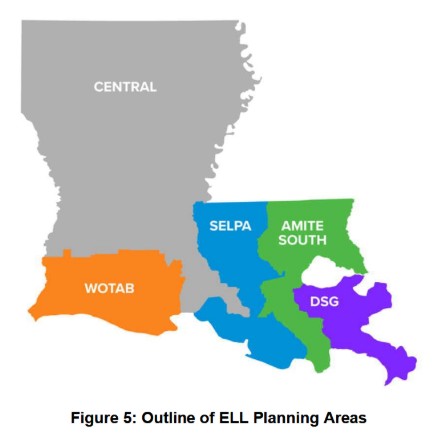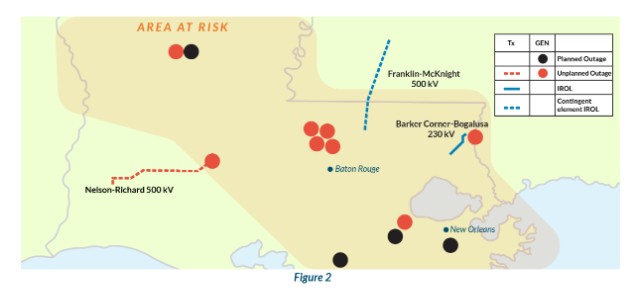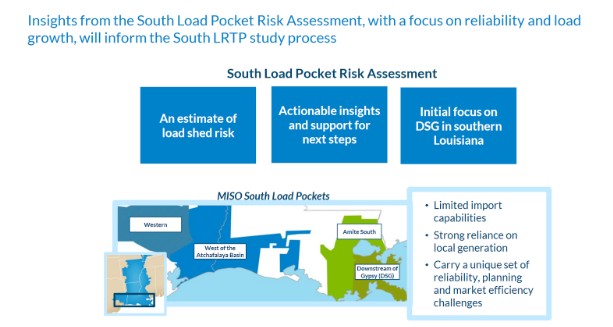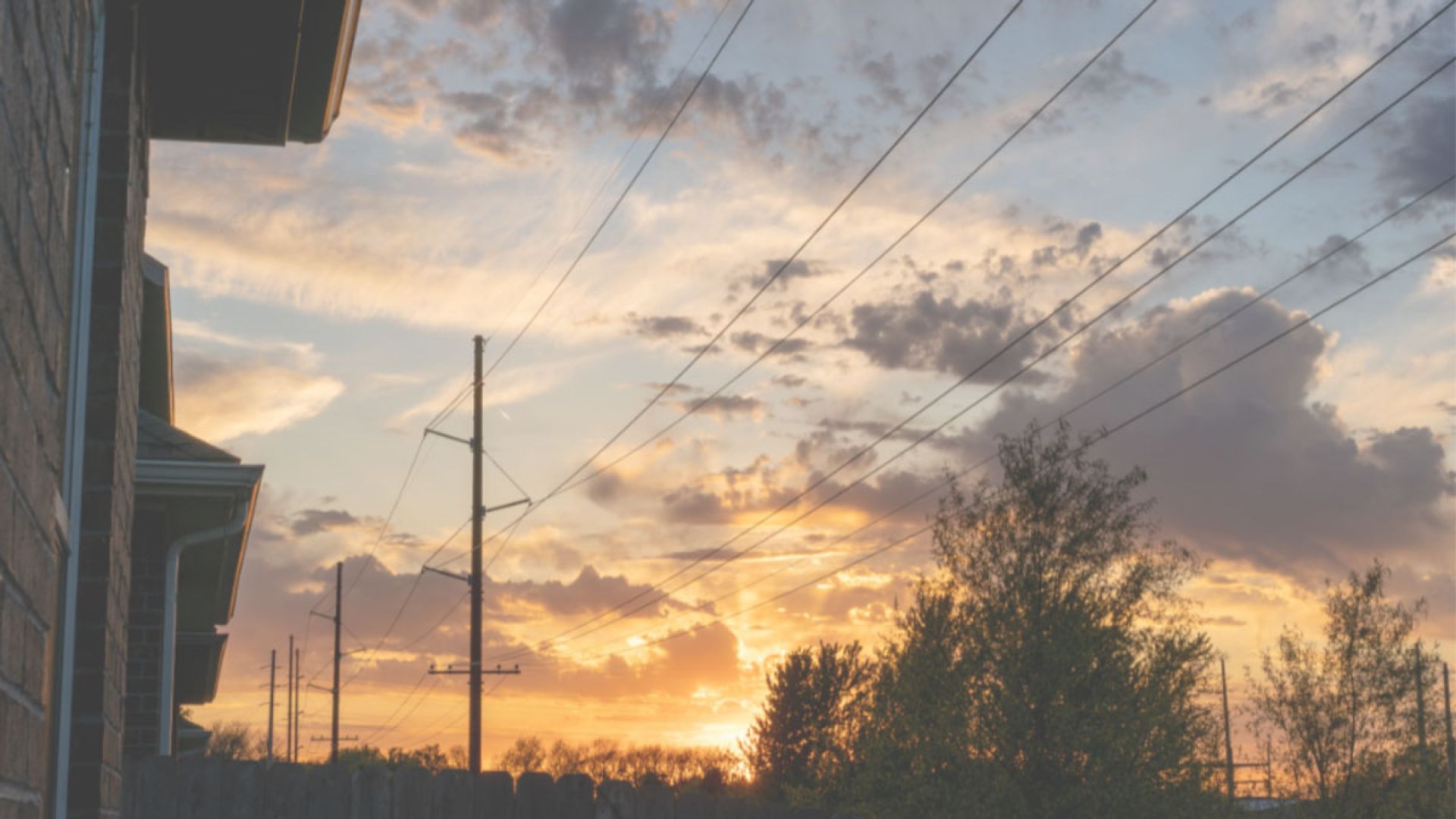Load pockets are areas on the grid with limited import capability, meaning generation must be built within the pocket itself to meet demand. If generation inside that pocket fails for any reason - like it did for Entergy and Cleco on Memorial Day weekend - the situation can quickly snowball into insurmountable challenges and potentially lead to rolling black outs.
The Amite South load pocket in South Louisiana has long provided a system with many limitations for MISO and Entergy to work with, so it’s important to acknowledge that these load pockets didn’t just appear in 2025, or even five years prior. They have existed for decades.
- They've existed for so long that, prior to Entergy’s integration into the MISO footprint, operating protocols existed for when capacity emergencies should be called for when generation is limited in the load pockets.
- They've existed for so long that Entergy identified possible transmission improvements to improve reliability in the load pockets in 2006.
- They've existed for so long that, in the many years that Entergy has conducted Integrated Resource Plans (IRP), the Downstream of Gypsy (DSG), Amite South, and West of Atchafalaya Basin (WOTAB) load pockets have existed as ‘Resource Planning Areas.’

Source: 2023 Entergy Integrated Resource Plan
In recent years however, it has been glaringly obvious that the design of Entergy’s system across the Gulf Coast - spanning from Southeast Louisiana to Southeast Texas - has not been able to keep pace with demand on the electric system. Before the May 25 event, blackouts occurred in relation to events like Hurricane Laura and Winter Storm Uri, situations where customers were affected by Entergy’s limited ability to transfer power across their system - which is something that’s been acknowledged by Entergy in recent large-scale investments they’ve proposed in these load pockets.
Transmission, unfortunately, is not top of mind in Entergy’s After Action Report discussed at the October 23 (LPSC) meeting.
Anatomy of a Blackout - Entergy and MISO’s Takes on the May 25 Event
Both MISO and Entergy provided their analysis regarding the May 25 event, pointing out that communication with the public, as well as coordination with each other, needs to be improved. Early warning is critically important for regulators, and their constituents who expect the power system to be functioning for events of this magnitude, they said. To lose 498 megawatts (MW) of electricity across the Greater New Orleans area is a hazard to public safety at most, and a major inconvenience at least. Both the MISO and Entergy reports call for greater communication through Emergency Condition declarations and coordination between the system operator MISO, who sees a much wider view of the system, and Entergy’s Transmission Control Center (TCC) who is limited to the control of their utility territory, or balancing authority. It’s worth mentioning though, that the conditions leading to the blackout are very rare, as are load pockets like Entergy’s.

Source: May 25 Load Shed Event August 2025 Report
Initiating a blackout is every system operator’s worst nightmare. It’s a last resort, and something not to be taken lightly. On May 25, the unavailability of more than 50% of local generation due to outages and 'limited transmission import capability’ led to system operating conditions so challenging that there was no alternative but to initiate a blackout across Greater New Orleans in order to preserve the larger electricity system.
While Entergy points the finger at MISO in their After Action Report for instituting a new rule relating to planned power outages over 31 days, which apparently affected the outages of 2,492MWs across Waterford 3, Ninemile 4, Perryville 1, and Perryville 2, it did not impact the forced outages of their other generators.
The 1,035MW River Bend Nuclear facility sustained a coolant leak on May 21, and the 582MW Little Gypsy 3 Gas facility also sustained turbine vibration issues. Over 4GWs of Entergy resources were unavailable, along with nearly 1GW of non-Entergy, non-LPSC jurisdictional resources that were unavailable.
The unavailability of this generation is a major liability without a well-connected transmission system able to provide access to other generators when needed. It’s more than just outage schedules that created the load shed event. If there’s this many generators that need to take outages to prop up the system, it becomes a tenuous thing to balance the system with a limited set of generators.
The Louisiana Public Service Commission’s (LPSC) Staff Report discussed at the October 23 Business and Executive Session highlighted many valid concerns about lack of communication with the public, between MISO, Cleco and Entergy prior to the loadshed event, and most importantly, protocols around MISO’s identification of the Temporary IROL leading to the loadshed event. MISO agreed with many of the concerns raised by the Staff Report, and the remedies proposed by it, but the system operations and protocols have diminishing returns if the system itself is not improved.
‘All of the Above,’ Which Includes Transmission
The generation mix matters. Just as solar and wind are intermittent, other sources like gas, nuclear and coal can be unavailable for repairs or because of environmental impacts. Large rotating machines require cooling systems that can overheat or freeze up, leading to forced outages. All generation resources are weather dependent - it’s just a matter of how much so.
Maintaining reliability, fundamentally, is a matter of balancing the supply and demand equation. If the generation mix is entirely thermal - like coal, nuclear or gas - you need to rotate outages for maintenance and ensure that what’s left is able to perform. Otherwise, the grid goes down. This is why it’s crucial to not put all your eggs in one basket, so to speak.
It takes a thoughtful approach to planning for a reliable and affordable grid. A diverse portfolio of resources can share the burden of reliability. Solar, energy storage and wind can come online in the near future and maintain reliability very affordably when these resources are plentiful, and resources like gas, nuclear and coal are on planned or unplanned outages.

Source: MISO Entergy Regional States Committee Working Group Open Meeting
Being able to access an all-of-the-above pool of generation requires a balancing of transmission and generation costs. The official reports from Entergy, MISO and the LPSC Staff all acknowledge that the planned transmission in the load pockets - which has already been vetted through MISO’s MTEP23 and 24 planning cycles - will help mitigate the issues faced on May 25, but the job is not by any means finished.
Part of what’s missing is a more thorough investigation of how to balance the costs of building transmission and generation to keep the system afloat with regard to the load pockets. To do this, MISO could execute multi-value planning that looks at benefits like avoided capacity costs and reduced costs of energy. MISO has been doing this type of planning for the past five years in MISO South, and thankfully has been beginning to sketch out the details of their Long Range Transmission Plan (LRTP) for MISO South. Near term, there’s a specific focus on the load pockets in Louisiana which is critically important for solving reliability issues for this part of the grid for the long term.
Regional transmission expansion can provide valuable import capability into high demand areas, providing a greater pool of generation options when resources closer to demand are on outage. And while all the megawatts that aren’t used, energy efficiency, reliability and demand response are all incredibly important for a future outlook that only shows increasing demand and strain on the system. Above all though, the most critical resource needed in this mix is the support for these diverse resources by decisionmakers. Louisiana policymakers need to commit now to planning and funding policy decisions that enable a resilient, diversified mix.





